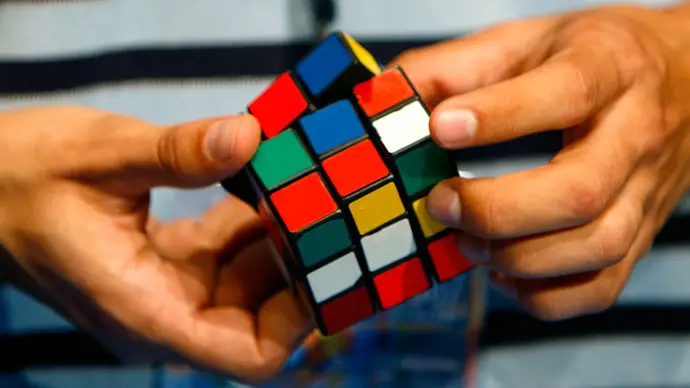What has six faces, 54 stickers and the ability to frustrate all who touch it? The answer, of course, is the infamous Rubik’s Cube. Invented in 1974 by Hungarian professor and architect Ernő Rubik, the Cube is the world’s top-selling individual toy, with over 350 million flying off the shelves since 1980.
Funnily enough, Rubik originally had a different use in mind for his creation: He planned to take the Cube to the classroom as a teaching aid for mathematics. Doing so, however, gave him the idea of marketing the Cube and making copies to distribute to a larger audience.
Rubik knew of his toy’s addictive powers, having previously spent over a month finding a solution to a scrambled Cube. Branding his invention the “Magic Cube,” he struck a manufacturing deal that quickly fell through, sending him back to square one.
It was only when the Cube was discovered by businessman Tior Laczi and Ideal Toy Corp. that Rubik’s dreams of mass production were brought to fruition. After a name change to the “Rubik’s Cube,” the rest, as they say, is history.
Of course, all good fads must eventually come to an end. After taking the globe by storm in the early ’80s (and spawning the first Rubik’s Cube world championship in 1982), the Cube mostly faded from the public eye for the next twenty years. In the early 2000s, however, Rubik’s gadget began making a comeback. A new generation embraced the Cube, and the puzzle became cool to own again. Sales rose dramatically, and they haven’t come back down ever since.
The Rubik’s Cube has worked its way nicely into the fabric of American pop culture. In the 2006 film “The Pursuit of Happyness,” for instance, Will Smith plays a man who solves a Cube during a ride in a taxi. His companion on the trip, a manager at a stock brokerage firm, is initially skeptical, but his disbelief transforms into awe when Smith’s character manages to re-align all of the Cube’s colors. The scene as a whole is meant to demonstrate the intelligence of the solver, who is offered an internship at the aforementioned firm due to his surprising accomplishment.
Unfortunately, though “The Pursuit of Happyness” helped draw attention to the Rubik’s Cube in the U.S., the film was yet another example of how society continues to promote misconceptions about the puzzle. Like many other things, misinformation about Cubes latches on due to a collective dearth of knowledge about the subject. Given time, these little half-truths become widely accepted as fact.
For starters, many people still hold those who are capable of solving Rubik’s Cubes in extremely high regard. Those who can somehow put a scrambled Cube back together must be geniuses and wicked smart, goes the common train of thought.
And if such a feat can be accomplished really quickly? Well, the faster the better. Even esteemed sites such as FiveThirtyEight are reduced to clickbait headlines like “A 14-Year-Old Just Solved A Rubik’s Cube In Under Five Seconds” whenever a new world record is set. And why not? After all, there are 43 quintillion possible configurations for each Cube!
The truth, as usual, is quite sobering, though perhaps a bit surprising as well. When someone like Tyson Mao says, “solving a Rubik’s Cube isn’t hard,” the natural reaction may be to scoff. Being a former world record-holder himself, Mao is obviously a bit biased, and his follow-up assertion that “it’s not impressive that a 5-year-old would be smart enough to solve a Rubik’s Cube” seems a little off-base.
Still, speedcubers — people who attempt to solve the Cube as fast as possible — rely on a set of algorithms that virtually anyone can pick up. These algorithms range in difficulty from complete newbie to advanced, but they center on a few basic principles: identify certain configurations of the Cube and carry out the appropriate set of moves for each position. With practice, algorithms can be memorized, and over time, they can become second nature.
So, the elite speedcubers don’t necessarily have the highest IQs and may not be light-years ahead of everyone else in terms of intelligence. Pretty much all of them didn’t come up with the algorithms they use on a daily basis — they just found them on the internet.
Of course, solving a Rubik’s Cube in under ten seconds does require plenty of skill. But excelling at pattern recognition and turning cubes quickly with unnerving accuracy doesn’t seem to be all that related to how smart a person is.
Media outlets, however, are all-too easily enamored by fast-moving hands. As a result, they miss the chance to engage in more accurate reporting on the world of cubing. A New York Magazine article, for instance, says the following of Lucas Etter, the first person to break five seconds on the Rubik’s Cube in competition: “He still holds the title for the fastest two-by-two cube, at 1.51 seconds.”
The mentioned time, however, is an average time, not a single time. At competitions, each round usually consists of five timed solves, the middle three of which are averaged for the final result. Single records can be set on any individual solve, but average records can only come about once a round is completed.
Thus, setting a world record average is actually more impressive than setting a world record single. Anyone can get a lucky scramble every now and then, but not everyone is consistent enough to sustain a record pace over several solves. As an example, Kim Roger Høyland Larsen once recorded an astounding 0.58-second solve of the 2x2x2 Cube in competition. Yet, he doesn’t even make the top 100 when it comes to the world’s fastest recorded averages.
The media doesn’t love world-record singles equally. Only times on the traditional 3x3x3 Cube are reported on, which is a shame, as the governing World Cube Association (which revived the Rubik’s Cube World Championship in 2003 and now holds the competition every two years) recognizes a wide variety of events. Some, like the aforementioned 2x2x2 Cube, rely on differently-sized puzzles, while others, like the Rubik’s Clock, have a completely different look to them.
Other events are more esoteric, such as Fewest Moves, in which competitors are given a set of 3x3x3 scramble instructions and asked to come up with an original solution. Others, like Feet and One-Handed, are offbeat and a little odd.
Perhaps the most impressive events of them all, however, are the blindfold ones, in which competitors inspect the Cubes before donning the requisite eyewear. Think solving one Rubik’s Cube blindfolded sounds hard? Try doing 41 of them within an hour without making a mistake.
But perhaps the best (and most overlooked) part of cubing is the community. Browse SpeedSolving.com, an online cubing discussion forum, and you will quickly get a sense of the general character of speedcubers. You would be hard-pressed to find individuals who better embody the spirit of “friendly competition.”
Cubers are extremely kind, and they will not hesitate to congratulate each other on their accomplishments. Sure, everyone wants to do well, but no one lets their competitive drive affect their interactions with others. Cubers also have a terrific sense of honesty. Who else would modify the title of YouTube videos to indicate that the world record times in them have since been surpassed?
By all indications, the Golden Age of Cubing is happening now. It seems that no matter where you go, you can find people who are interested in twisty puzzles. Google, for instance, donated computing power to help discover the maximum number of moves needed to solve a Rubik’s Cube from any scrambled position (it’s 20, if you were wondering).
World record times for virtually all events are plummeting, and even robots seem to have the need for cubing speed. Speedcubers such as multi-world record-holder Feliks Zemdegs and Mats Valk have even achieved minor celebrity status in their home countries and abroad.
With a new generation headed by cubers like Max Park on the rise and corporate sponsorships of Rubik’s Cube events steadily increasing, the sky is truly the limit for the world of cubing. Will speedsolving become as popular as chess? Will cubing’s gender gap decrease? We’ll have to wait and see. In any case, there is a lot to be gained from the success of the forty-year-old device.
Learning to solve a Rubik’s Cube the hard way can open doors, whether it be through making new friends at competitions or developing a curiosity for mathematical patterns and algorithms. Plus, you’d feel a lot worse if you just re-arranged the stickers.











This was too good??
Fewest Moves solver checking in.
For Fewest Moves, not only are you allowed a cube to use–you can bring three: https://www.worldcubeassociation.org/regulations/#E3b
This article is great in a lot of respects, but fell short regarding in the tip-top, number one BEST event.